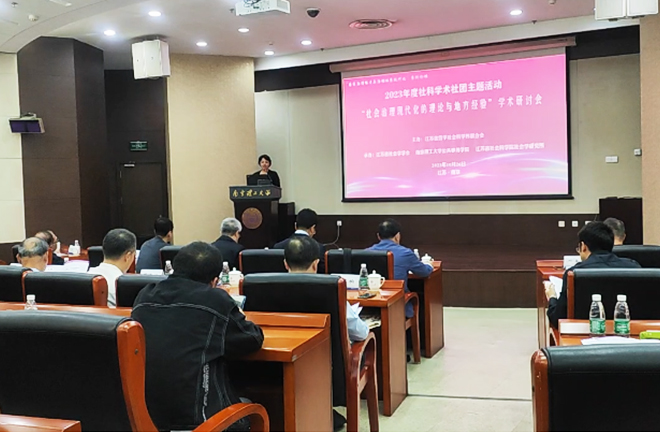Scholars seek solutions to challenges of social transition

A seminar on social governance modernization took place in Nanjing, Jiangsu Province, on October 26. Photo: NJUST
NANJING—As China has miraculously achieved rapid economic growth and enduring social stability throughout its transformation, its progress has also presented challenges. At a seminar on social governance modernization in Nanjing, Jiangsu Province, on October 26, scholars exchanged views on the risks of social transformation, explored ways to further modernize China’s system and capacity for governance, and offered suggestions for long-term social stability and sustainable development.
Social transformation
In the process of transformation, China’s urban middle-income groups and their sense of identity have also changed. Wu Yuxiao, deputy dean of the School of Social and Behavioral Sciences at Nanjing University, investigated the proportional change of this group in China since the beginning of the 21st century, the matching of their objective and subjective identities, and the subjective judgment of social mobility and future expectations. According to the 2003–21 data of the Chinese General Social Survey, the proportion of urban middle-income groups ranged between 30% and 50%, displaying an “inverted U-shaped” pattern of steady rise and then decline. From the perspective of subjective measurement, the subjective income identity of the group has shown a steady upward trend, but the growth rate is slowing down or even tending towards decline. Survey respondents perceive obvious upward mobility over the past decade, and have clear expectations of upward mobility in the coming decade, indicating that middle-income groups have high confidence in upward mobility.
China’s social governance is currently characterized by digital, intelligent, precise, and professional development. Song Linfei, dean of the Qu Qiubai School of Government at Changzhou University, noted the use of big data, cloud computing, artificial intelligence, and other cutting-edge technologies to innovate urban management methods, models, and concepts. Transitioning from digitalization to intelligence to smartness is an inevitable way to modernize urban systems and their capacity for governance.
The core of social modernization lies in the modernization of social structures. Gu Hui, a professor from the School of Public Affairs at Nanjing University of Science and Technology, proceeded from the perspective of social structures to understand Chinese modernization. Based on a quantitative analysis of the urban-rural social structure, Gu found that the structure still exhibits characteristics of an “onion-shaped structure.” Specifically, the urban structure resembles an olive, and the rural structure manifests a pyramid-like form. At the same time, the public-sector structure displays an olive-like configuration, while the non-public sector exhibits a pyramid structure. While the urban-rural dual social structure in China lays the groundwork for social stability, it also poses challenges to the establishment of an olive-type social structure, which is deemed necessary but not entirely sufficient for Chinese modernization. Additionally, society must maintain a moderate level of mobility.
An aging population
The latter half of the 21st century will see China transitioning into an aging society marked by exceptional stability. “At present, the mode and quality of life of the elderly have gradually become a hot topic, which requires researchers and policy makers to evaluate and improve from multiple dimensions such as education, family, and health,” said Ye Nanke, former president of the Nanjing Academy of Social Sciences. Ye suggested that aging be seen as a positive result of modernization. Given the challenges of the “digital divide” and “intelligent barrier” that the elderly encounter, it is crucial to facilitate their integration into modern society through “back feeding” from the younger generation and community support. This will enable the elderly to maintain active social engagement.
The rapidly growing elderly population is a major issue concerning people’s livelihood, national security, and even overall development. Shi Guoqing, a professor from the School of Public Administration at Hohai University, introduced the evolution, theoretical connotation, ethical framework, action strategy, and measurement elements for the concept of “active and healthy aging,” initially proposed by the European Union. This provides a valuable point of reference for other countries, including China. It is essential for the country to review the relevant policy framework and implementation process from the standpoint of social structure equality, government responsibility, public health, and other perspectives, in order to better support initiatives for active and healthy aging.
“Aging itself is not a problem, the problem is that the system and capacity for social governance are not quite ready yet,” said Sha Yong, dean of the School of Sociology and Population Studies at Nanjing University of Posts and Telecommunications. Sha suggested enhancing the social governance of the elderly across five dimensions. In terms of finance, substantial fiscal resources are required in areas related to people’s livelihood, aiming to elevate the level and quality of their wellbeing. Concerning policies, greater efforts should be made to improve subsidy policies to ensure the livelihood of the elderly, supportive policies to encourage their engagement, coordination policies to facilitate their learning, precise support policies for special groups, and an overarching policy combining medical care and endowment. Addressing mechanisms, attention must be given to the challenges of urban-rural duality, group duality, and mechanism duality in elderly care. Regarding manpower, the government can procure services so that the relatively younger elderly can provide care services for the elderly. Finally, in terms of concepts, it is necessary to rebuild the subject position of the elderly and enhance their living standards.
Edited by YANG LANLAN
